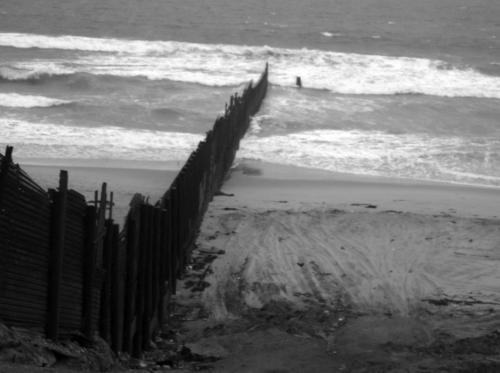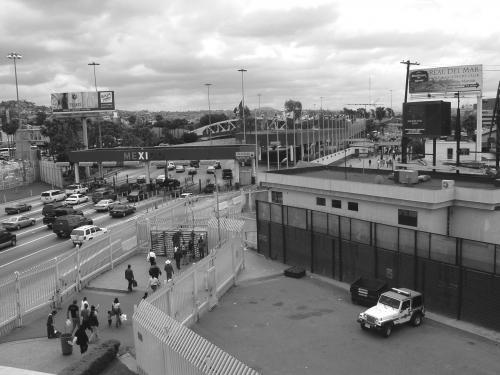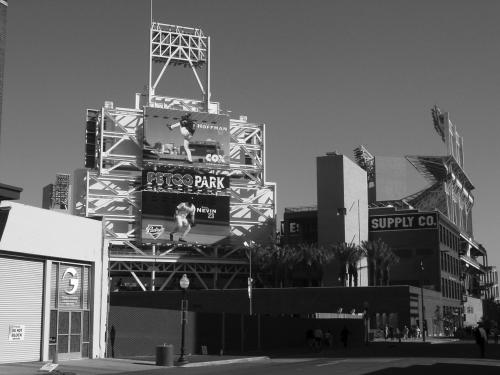On the second day of the SPUR study trip to San Diego, we visit the U.S.-Mexico Border Station, an imposing and unlovely network of automobile checkpoints, fences, administrative offices, detention areas, parking lots, and a single pedestrian passageway from Tijuana to San Ysidro: one way in, one way out. As SPUR study trip members are prone to do, we spill out of the bus to gesticulate energetically at areas of particular interest. We converse animatedly in groups. We point and shoot with our cameras. And we attract the notice of border security guards, filming us in turn on closed circuit television, swooping down as if from nowhere to tell us to move along and, even more imperatively, to STOP TAKING PICTURES or our cameras will be confiscated IMMEDIATELY and we will be detained for HOURS OF QUESTIONING.
Welcome to the 21st century, where the border is definitely not in order.

A 15-foot high corrugated metal fence runs along the border and into the Pacific Ocean at Imperial Beach.
Mexican border towns, Tijuana in particular, have long served as "escape valves" - places where whores, horse racing, bullfighting, cheap liquor, and souvenir serapes provide an easily accessible exoticism for U.S. dollar-rich daytrippers. But increasingly the border has been challenged, practically if not politically, by a social economy and urban ecology that confounds its "us-them" logic. San Diego and Tijuana share watersheds and a common terrain of scrub hillsides, mesas, and arroyos. They share a common history of Spanish exploration and settlement, perhaps most poignantly illustrated by the Forbes Mission bell, used to mark the Camino Real, that is placed right next to the revolving metal gate at the pedestrian crossing (I pause for a moment, trying to imagine Father Junipero Serra pushing past its clanking bars). The two cities share an ever deepening biculturalism, an increasingly commingled workforce and a web of bedroom communities - San Diego's population of 1.28 million is matched - and at a growth rate of 6.2% annually soon to be surpassed - by Tijuana. 60 million people, in cars and on foot, cross the border legally every year through this single portal - more than 50,000 every day - making it the busiest international border crossing in the world. Many Mexican nationals work in the San Diego area. And a growing number of U.S. nationals live in Tijuana, where the cost of home ownership is significantly lower.
These are some of the reasons why it might make more sense to talk about a greater San Diego-Tijuana metropolitan region rather than a U.S.-Mexico border. Or at least this is what some of the residents of San Ysidro, the San Diego community adjacent to the border, had in mind when they convened a conference entitled "Border Dialogues" to explore the possibility of reimagining the border as a common, connecting civic space rather than a cordon sanitaire between one place and another. The SPUR study tour stopped briefly at the conference so that we could take in some of the recommendations made by an international roster of urban designers, landscape architects, and cultural geographers, who envision an aesthetic of permeability and transition, including multiple pedestrian throughways and a greensward rather than corrugated metal barriers at the border. Their suggestions are strikingly reminiscent if less ambitious than a plan put forward by Kevin Lynch and Donald Appleyard in 1974. This privately sponsored report, entitled Temporary Paradise , proposed not only "green" agricultural and recreational uses around a border crossing of multiple access points, but an international airport shared by both Tijuana and San Diego, coordination of water usage and other natural resources, and joint cultural institutions including an "Interamerican University."1

The San Ysidro Border Station, currently being evaluated for upgrade and expansion by the General Services Administration.
Petco Park, designed by HOK Sport on an 18-acre site at a cost of $449.4 million. Opened 2004.
The Federal government, however, has other ideas. (Remember those stern warnings to the SPUR crowd against inexplicably enthusiastic group assemblies and unauthorized photography?) In a post 9/11 world, an open border is a potential conduit for terror; a kinder, gentler crossing is just asking for trouble. The General Services Administration's no-frills, no-funny-business proposal to "upgrade" the border station includes increased emphasis on managing car traffic and football field-sized employee parking lots whose hot asphalt surfaces would create a desert-like no-man's land between the two nations.
No wonder the people who live along the border are trying to take matters into their own hands. But why should SPUR members interested in issues of good urban planning and the quality of urban life care about the border station? Granted, the economic and social issues surrounding U.S. immigration policy are complex, and the design of the border is unlikely to be ceded to a municipal authority, no matter how utopian or imaginative the plan.2 But when the President of the United States declares, as he did a few months ago on the anniversary of the beginning of the war in Iraq, that "our cities are battlegrounds," then we have to grapple with the underlying implication: today every major city stands at the juncture between "us" and "them," and every one of our urban public spaces constitutes a potential border crossing.
This is why, like it or not, we should take the San Ysidro Border Station seriously as an example of monumental civic architecture - it has a lot to say about how our public institutions seek to structure public space and mediate encounters between strangers. And that thinking translates to other instances of civic architecture, where the idea of a border is less overtly contested but no less present within the design. In Temporary Paradise, Lynch and Appleyard likened the appearance of the Border Station to the chutes at a Tijuana dogracing track. Today another comparison comes to mind - the new Petco Park, recently built to house the San Diego Padres baseball team.
The chance resemblance is sort of funny, but then again it's not much of a joke. According to that oddly contemporary urban aesthetic where even as city dwellers work less with their hands everything must appear more industrial, Petco Park has been cobbled together from newly minted structural elements of white-painted steel and the remnants of old brick warehouses, the whole thing festooned with paid advertising, flags and bright lights - from certain angles it looks like a "positive" vertical accumulation of the border station's "negative" horizontal sprawl. And like the border crossing, its ostensibly haphazard work-a-day aesthetics are in the service of an extremely functional orchestration of human convergence. It's also one of the only "public" places in which to converge. Although there is some greenspace along the waterfront and a depressingly unplayful children's park several blocks away, Petco Park represents the major investment in open space in the downtown redevelopment area?aside from restaurant patios, there's not a lot of other options if you want to sit outside and enjoy the company of your fellow man.

Piazza Basilone, at the corner of Fir and India Streets. Funded by public grants and private donations at a cost of $350K. Opened 2004.
Major sports stadiums may be tempting targets for terrorism, but they are also gated, admission is regulated by fee, baggage and body searches can be imposed, patterns of human activity are predictable and under constant surveillance, and aberrant behavior is easily detectable (you're either watching the game or you aren't). These security features become more highly valued not only in times of social or political unrest, but also in times when urban homeless populations put increasing pressure on the distinction between loitering and leisure in public places. By defining our sense of who has the right to hang out or move around, to come and go freely, and even to do apparently innocuous things like sleeping, eating, or taking snapshots, the real politics of public space govern our feelings of trust, common cause, and human togetherness — or suspicion, segregation, and alienation.
Perhaps this explains why I find another recently minted public space we visited on the San Diego trip much more hopeful in terms of its significance for an urban frontier. In the old-time neighborhood of Little Italy, redevelopment energy that has brought significant new higher-density housing projects to the area has also mobilized business owners and residents into the Little Italy Association, a non-profit improvement group. Their most recent project is the small, circular Piazza Basilone, ingeniously carved from a side street to capture some of San Diego's overabundant car space as precious (and scarce) pedestrian open space. There is a fountain and a memorial to local residents who died in the wars of the 20th century. A portion of the retaining wall has been stepped to provide seating, portable chairs are also scattered about. It's modest in its square footage, but heroic in its convictions about what makes a real community — welcoming places to meet your neighbors, a seat that's free for the asking, and strongly designed edges that are not doing double duty as barriers.
Taken together these three projects — border station, ballpark, and mini-piazza — are radically different in scale, cost, and function. But they all participate in a "border dialogue" about the quality of human encounters in our cities, our sense of common ground, and where we draw the line. A few weeks after we return home, I am giving an urban designer visiting from New York a tour around San Francisco's downtown. We stop for a moment at the recently renovated Union Square. After the obligatory banter about the expanse of hardscape (everyone's a critic), the conversation took a more unexpected turn. "It's so open," she marveled. "We're having a hard time imagining anything like this in New York right now." The feeling is understandable, but here is what I learned in San Diego: all the reasons why we must.
ENDNOTES
1 - Donald Appleyard and Kevin Lynch, Temporary Paradise: A Look at the Special Landscape of the San Diego Region (San Diego: City Planning Department, 1974): 37-40.
2 - For a summary of those challenges, see the recent two-part special report, "Dangerous Border," in the San Francisco Chronicle, May 30-31, 2004.